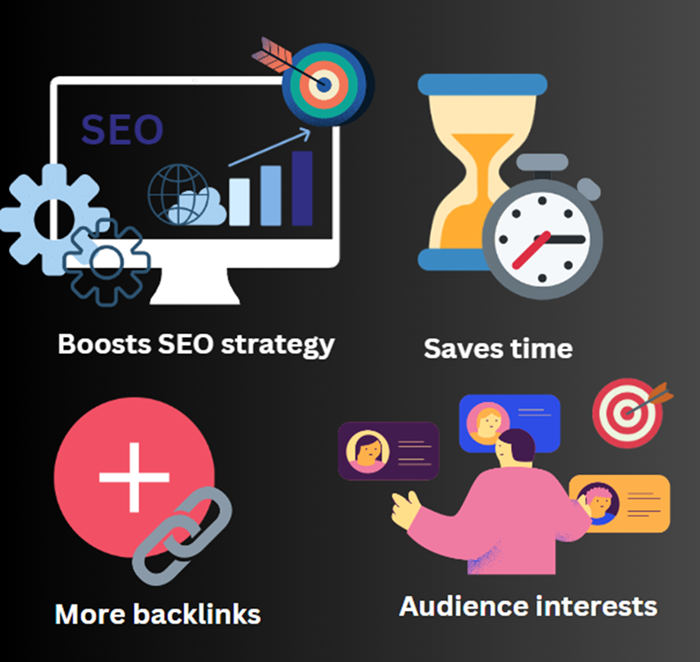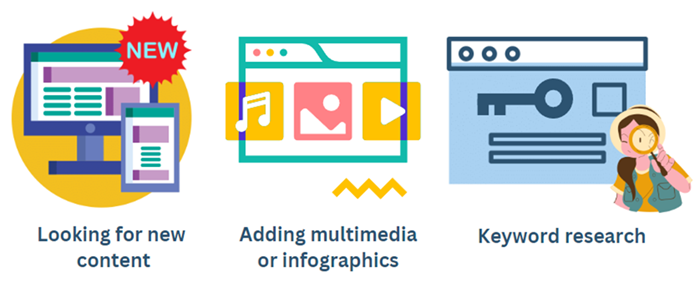
- SEO - Home
- SEO - What is SEO?
- SEO - Tactics & Methods
- SEO - On Page Techniques
- SEO - Off Page Techniques
- SEO - Web Site Domain
- SEO - Relevant Filenames
- SEO - Design & Layout
- SEO - Optimized Keywords
- SEO - Long-tail Keywords
- SEO - Title Tags
- SEO - Meta Description
- SEO - Optimized Metatags
- SEO - Optimize for Google
- SEO - Robots.txt
- SEO - URL Structure
- SEO - Headings
- SEO - Redirects
- SEO - Authority & Trust
- SEO - PDF Files
- SEO - Optimized Anchor
- SEO - Optimize Images
- SEO - Duplicate Content
- SEO - Meta Robots Tag
- SEO - Nofollow Links
- SEO - XML Sitemap
- SEO - Canonical URL
- SEO - Role of UI/UX
- SEO - Keyword Gap Analysis
- SEO - Get Quality Backlinks
- SEO - Adding Schema Markup
- SEO - Author Authority
- SEO - Fix Broken Links
- SEO - Internal Page Linking
- SEO - Clean Up Toxic Links
- SEO - Earn Authority Backlinks
- SEO - Core Web Vitals
- SEO - Update Old Content
- SEO - Fill Content Gaps
- SEO - Link Building
- SEO - Featured Snippets
- SEO - Remove URLS from Google
- SEO - Content is the King
- SEO - Verifying Web Site
- SEO - Multiple Media Types
- SEO - Google Passage Ranking
- SEO - Maximize Social Shares
- SEO - First Link Priority Rule
- SEO - Optimize Page Load Time
- SEO - Hiring an Expert
- SEO - Learn EAT Principle
- SEO - Mobile SEO Techniques
- SEO - Avoid Negative Tactics
- SEO - Misc Techniques
- SEO - Continuous Site Audit
- SEO - Summary
- SEO Useful Resources
- SEO - Quick Guide
- SEO - Useful Resources
- SEO - Discussion
SEO - Update Old Content
Contrary to what most teams believe, you may get better results by taking care of the material previously posted on your site. You most likely have a backlog of old material on your website, pieces that have not been touched in the several years since they were published.
While you must check in with them regularly, your target consumers (and Google) are likely. It might jeopardise your content marketing plans if they aren't up to date.
Content Refresh: What Is It?
A content refresh is an upgrade to your current material that answers search intent with enhanced data, expertise, quotations, and examples and demonstrates to search engines that you are still a reliable source for the searched query.

Why Should Old Blog Posts Be Updated?
Before we begin, let's lay the groundwork and consider why you should upgrade existing blog entries (rather than simply pushing "publish" on new content each week.)
Updating outdated information helps in three ways −
Boosts your SEO strategy − Search engines are meant to locate the most accurate and helpful material for consumers. Relevant, new information is prioritised, while older stuff gradually drops in the rankings. This might hamper your content value and SEO efforts over time.
By going in and upgrading old information, you show search engines that what you publish is current, accurate, and relevant.
Save time while getting results: Redoing an existing article takes far less time than writing a new one.
This does not imply that you should stop creating content entirely, but allocating time to both practices can produce outcomes with much less effort.
Earn more backlinks: Updating outdated material allows you to gain more backlinks from reputable domains.
Enhance audience interests: Consider yourself as a member of your intended audience. Do you enjoy reading obsolete and stale content? No, is the apparent response here. If a reader comes upon one of your earlier works, you want them to stay and read it. Fresh material with recent information can keep visitors interested, increase organic traffic, and decrease bounce rates.

Finding or Choosing Which Content to Update
Now that we've established why upgrading old material should be a top priority for your website, let's get to the challenging part: choosing which blog entries to update.
Keep an eye out for the following while looking for sites to update −
Previously high-ranking pages that have slipped in rankings
Content decay occurs when a blog post loses ranks for a specific keyword and traffic declines. This material often performed well at first, but growth began to slow and finally stall when search engines realised it wasn't serving the topic as effectively as it used to, or competitors produced better or more recent information on the same issue.
You may uncover these possibilities by comparing Google Analytics reports for Behaviour > Site Content > All Pages.
Certain pages for which high expectations never materialised
When you discover an article with a solid plan and adequate execution does not rank, you should investigate why.
This material is ideal for revision since you can figure out what went wrong (or hasn't been optimised), repair it, and expand your knowledge of best practices.
Pages that include seasonal content
Most excellent content marketing programs will include a variety of material forms that are relevant on a seasonal, yearly, or other repeating cycle.
Such material should be evaluated regularly and revised a few months before it becomes relevant.
Refreshing, updating, and pushing such information is frequently the only way to keep rankings consistent yearly.
Best Practices to Update Old Content
Updating your content may involve something other than sifting through your material to identify what can be modified or building a new page from scratch.
To improve the quality of your content, here are five approaches you may look for −
Search for newer content on the same topic
A short research on the subject should reveal whether updated data is accessible. If there is, update the facts and numbers in your writing and the resources you link to reflect the latest research.
Remove unnecessary information and replace it with helpful tips.
Even popular information is subject to change. For example, knowledge about a country's president might instantly outdated your article, even if it ranked wellat the time of publishing.
Undertake keyword research
Once you've decided on the keywords you want your content to rank, you may assess your page's header, description tag, and subheadings. These parts should represent searcher language by employing exact matches, close matches, or by addressing a question the searcher has posed.
Include Appropriate Multimedia
Visuals provide dimension to your material and break up words making it more readable; they may even communicate information more effectively in some cases. Consequently, adding graphics to a page is a simple and uncomplicated way to improve the user experience. The idea is to include relevant, valuable multimedia.
Check the internal and external links
Check each link in your post to ensure they all redirect to a functional website. If not, it's time to find new pages to replace it. Also, seek fresh possibilities to build internal links. Your older pieces have space for connections to your fresh content. Including references to other relevant sites on your website can assist in routing traffic to those pages and keep visitors on your site.
Avoid altering the URL
If your old blog article contains inbound links, whether via guest posting, organic links, or another source, changing the URL will make them ineffective. When an individual clicks upon the link to that specific post, they won't see your recently updated content. You want to maintain the SEO benefit of any existing connections to the page.

Alternative Ways to Update Old Content
Additional techniques for updating any piece of obsolete material on your website include.
Modify the formatting or layout.
Respond to "people also ask" questions.
Alter the alt text on your photos.
Include expert quotes
Remove any brand-specific references.
How Frequently Should One Update OldPosts?
Astudy discovered that mostposts go through three distinct life stages, which include −
Shout Phase − The post receives an exponential spike in impressions (about 50%) within the first 7-10 days.
Echo phase − The post receives 72% of its visits during the echo period, which usually lasts roughly 30 days following the shout phase.
Reverberate − This website post tracks the other 28% of its visits over a 30-700-day period.
With this in mind, upgrading your previous blog content provides several chances, such as increasing clicks, impressions, and conversions.
Conclusion
New only sometimes means better. If you desperately need a boost, put some time into upgrading outdated material, whether you're aiming for general SEO or local SEO. When done effectively, a content refresh may help you achieve substantial traffic results, keep your audience interested, and demonstrate to engines that your article deserves the top place on the SERPs.